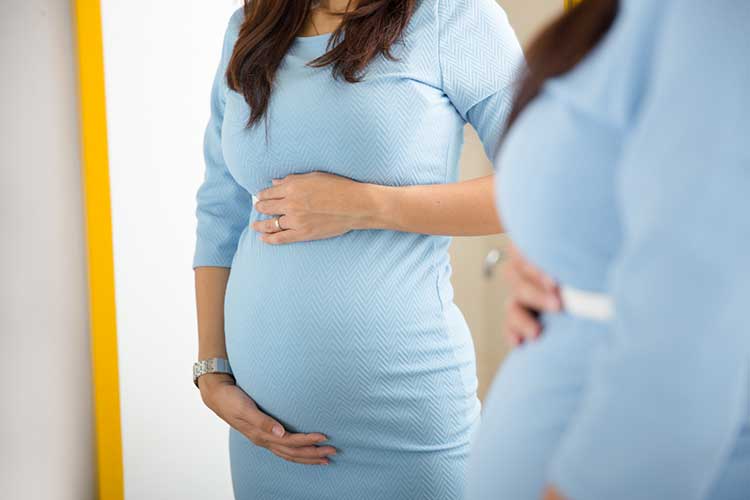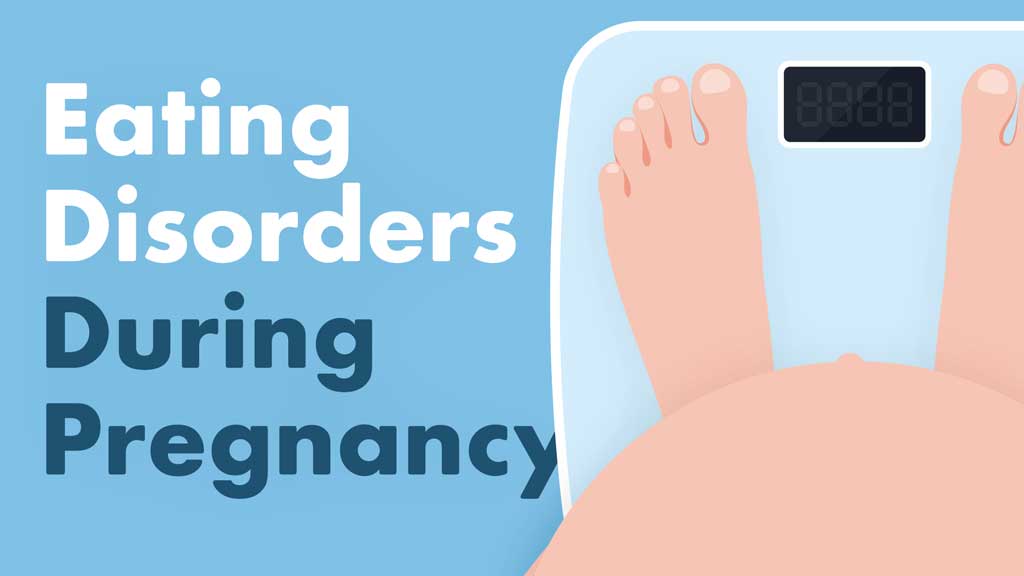Weight gain is an entirely natural aspect of a healthy pregnancy. However, for some women, their changing body shape can trigger heightened anxiety along with the emergence, or return, of an eating disorder.
Eating disorders typically affect women of childbearing age (Bye et al. 2018), and if left unmanaged, can be associated with adverse outcomes for both mother and baby. Good nutrition is essential during pregnancy, and even though eating disorders such as anorexia nervosa, bulimia nervosa, and binge eating disorder are well recognised, their management remains a challenge (Fogarty et al. 2018).
Currently, in Australia, about 15% of women will experience an eating disorder at some point in their lives (Butterfly Foundation 2022). The Centre of Perinatal Excellence (2023) estimates that about 7.5% of women will experience an eating disorder while pregnant. This means that a significant number of women will require specialised assessment and care during their pregnancy to ensure adequate nutritional intake.
Types of Eating Disorders
There are four eating disorders described by the DSM-5 (Diagnostic and Statistical Manual of Mental Disorders) that can threaten the wellbeing of both the mother and fetus (NEDC 2015).
The three most common eating disorders are:
- Anorexia nervosa: A disorder defined by the persistent restriction of energy intake, which leads to lower-than-normal body weight (BMI under 17kg/m2). It’s a condition driven by an intense fear of gaining weight, a preoccupation with appearance and a disturbed body image.
- Bulimia nervosa: This disorder is characterised by recurrent episodes of binge eating followed by compensatory behaviour such as self-induced vomiting, purging, fasting, excessive exercising, or the misuse of laxatives and diuretics. It’s also characterised by a subjective feeling of loss of control when eating and is constantly associated with feelings of self-evaluation and low self-worth.
- Binge eating disorder: Typically, a large amount of food is consumed in a short period of time, often alone and with no sense of control whilst eating. Feelings of guilt, shame and loss of control are common after overeating. Unlike other eating disorders, binge eating is not associated with purging or other weight maintenance behaviours.
(SA Health 2020; National Eating Disorders Collaboration 2015)
Eating disorders not otherwise specified (EDNOS) tend to be characterised by fewer, milder symptoms but are still technically considered to be eating disorders (The Women's 2014).

Assessing the Risks
Both mother and baby are at risk when there is prolonged poor nutrition during pregnancy. Before pregnancy, women with eating disorders may present with menstrual dysfunction, low bone density and sexual dysfunction. Once pregnant, however, they are at increased risk of many obstetric complications such as miscarriage, preterm delivery or a low birth weight baby (Arnold et al. 2019).
Relatively little current research is available, however, in 2019 Charbonneau and Seabrook investigated available studies on the effects of eating disorders in pregnancy and found that there was an association between eating disorders and preterm birth in 36% of the studies, and small for gestational age babies in 63%.
Risks For the Mother
- Malnutrition, dehydration and possible cardiac irregularities, especially with bulimia
- Prolonged healing from a caesarean birth, episiotomy or perineal tear
- High blood pressure and gestational diabetes, particularly with binge eating disorders
- Depression during or after pregnancy
- Anaemia
- Increased risk of miscarriage.
Risks For the Baby
- Malnutrition
- Premature birth
- Low birth weight, especially if the mother has anorexia and a low body mass index (BMI)
- High birth weight if the mother has binge eating disorder
- Poor development
- Feeding difficulties
- Respiratory distress
(Eating Disorders Victoria 2024)
Barriers to Seeking Help
Bye et al. (2018) describe five main barriers to disclosing eating disorders in pregnancy, as perceived by women:
- Stigma
- Lack of opportunity
- Preference for self-management
- Current symptomatology
- Illness awareness.
They also identified the following four themes, which were seen as barriers to identifying eating disorders both during and after pregnancy:
- System constraints
- Recognition of role
- Personal attitudes
- Stigma and taboo.
Helping Women Adapt to a Changing Body Image

The combination of a rapidly changing body shape along with a susceptibility to eating disorders, or a history of previous disorders, can leave some women feeling vulnerable as their body image changes in ways that are beyond their control during pregnancy (Fogarty et al. 2018).
As Bye et al. (2018) suggest, midwives and health visitors are ideally placed to identify and support these women, as they are often the primary point of contact during the antenatal and postnatal periods.
Screening women for increased eating disorder symptoms, especially if they have had past symptoms or are experiencing current difficulties, is key to offering practical and effective support, as past difficulties tend to resurface during pregnancy, albeit usually in a milder form (Arnold et al. 2019).
Where possible, access to an interprofessional team should be made available during pregnancy, including a midwife, family doctor, dietician, eating disorder specialist and obstetrician. Care should also be extended into the postpartum period, as the risk of relapse or postnatal depression can be particularly high at this time (SA Health 2020).
One tool that is commonly adopted to help identify eating disorders in the antenatal period is the SCOFF questionnaire. This is a simple screening tool that midwives can use during antenatal visits to help identify women who may need further monitoring or referral to specialised services. Answering ‘yes’ to two or more of the following questions can be an early indicator of anorexia nervosa, bulimia or binge eating disorder:
- S - Do you make yourself sick because you feel uncomfortably full?
- C - Do you feel like you lose control when you are eating?
- O - Have you recently lost one stone (6.35 kilograms) in 3 months?
- F - Do you believe you are fat although others say you are thin?
- F - Would you say food dominates your life?
(SA Health 2020)
Avoiding Red Flag Times
Eating disorders seldom disappear completely at the end of pregnancy and it’s important that any support initiated during antenatal care is maintained into the postnatal period to avoid any ‘red flag’ times when discontinued care may leave a woman vulnerable to further relapse (Fogarty et al. 2018).
Although the care pathway for women with eating disorders may seem multi-faceted and complex at times, it’s important that every opportunity is taken to help them overcome the disorder. Without this help, not only is the mother’s health at risk, but also the short and long-term health of the child, who may become at greater risk of developing an eating disorder in later life (Arnold et al. 2019).
Test Your Knowledge
Question 1 of 3
According to the SCOFF questionnaire, how many ‘yes’ answers indicate a potential eating disorder?
Topics
Further your knowledge
References
- Arnold, C, Johnson, H, Mahon, C & Agius, M 2019, ’The Effects of Eating Disorders in Pregnancy on Mother and Baby: A Review’, Psychiatria Danubina, vol. 31, sup. 3, viewed 17 March 2025, https://hrcak.srce.hr/file/383731
- Butterfly Foundation 2022, The Reality of Eating Disorders in Australia, Butterfly Foundation, viewed 17 March 2025, https://butterfly.org.au/wp-content/uploads/2022/08/The-reality-of-eating-disorders-in-Australia-2022.pdf
- Bye, A, Shawe, J, Bick, D et al. 2018, ‘Barriers to Identifying Eating Disorders in Pregnancy and in the Postnatal Period: A Qualitative Approach’, BMC Pregnancy and Childbirth, vol. 18, no. 1, viewed 17 March 2025, https://link.springer.com/article/10.1186/s12884-018-1745-x
- The Centre of Perinatal Excellence 2023, Eating Disorders During Pregnancy, COPE, viewed 17 March 2025, https://www.cope.org.au/expecting-a-baby/mental-health-conditions-pregnancy/eating-disorders-during-pregnancy/
- Charbonneau, K & Seabrook, J 2019, ‘Adverse Birth Outcomes Associated with Types of Eating Disorders: A Review’, Canadian Journal of Dietetic Practice and Research, vol. 80, no. 3, viewed 17 March 2025, https://dcjournal.ca/doi/abs/10.3148/cjdpr-2018-044
- Eating Disorders Victoria 2024, Eating Disorders in Children, Teens, Midlife and Pregnancy, Eating Disorders Victoria, viewed 17 March 2025, https://eatingdisorders.org.au/eating-disorders-a-z/eating-disorders-in-children-teens-midlife-and-pregnancy/
- Fogarty, S, Elmir, R, Hay, P & Schmied, V 2018, ‘The Experience of Women with an Eating Disorder in the Perinatal Period: A Meta-ethnographic Study’, BMC Pregnancy and Childbirth, vol. 18, no. 1, viewed 17 March 2025, https://bmcpregnancychildbirth.biomedcentral.com/articles/10.1186/s12884-018-1762-9
- National Eating Disorders Collaboration 2015, Pregnancy and Eating Disorders: A Professional’s Guide to Assessment and Referral, NEDC, viewed 17 March 2025, https://nedc.com.au/assets/NEDC-Resources/NEDC-Resource-Pregnancy.pdf?2025031704
- SA Health 2020, South Australian Perinatal Practice Guideline: Eating Disorders and Pregnancy, Government of South Australia, viewed 17 March 2025, https://www.sahealth.sa.gov.au/wps/wcm/connect/a13c27004ee217a7b435bdd150ce4f37/Eating+Disorders+and+Pregnancy_PPG_v3_0.pdf?MOD=AJPERES&CACHEID=ROOTWORKSPACE-a13c27004ee217a7b435bdd150ce4f37-nGDIKdF
- The Women's 2014, Eating Disorders in & After Pregnancy, The Royal Women's Hospital, viewed 17 March 2025, https://www.thewomens.org.au/health-information/pregnancy-and-birth/mental-health-pregnancy/eating-disorders-in-after-pregnancy
 New
New 

